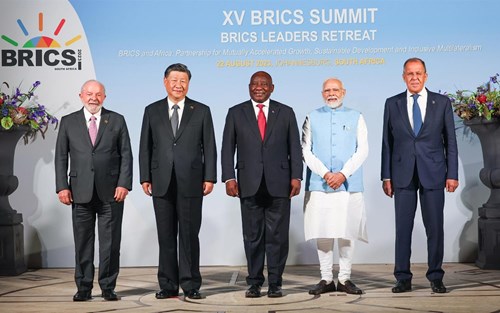
Ravenscroft CIO Kevin Boscher considers the challenges facing markets and outlines why nobody knows exactly what will come next.
A very uncertain and confusing macro backdrop
Markets have continued to be volatile and challenging over the past few months as investors try to come to terms with a very uncertain and confusing macro backdrop. I struggle to remember a similar period throughout my career where there has been less conviction and clarity on the economic, political and market outlook. Much of this, of course, relates to the unprecedented sequence of events that has unfolded since the pandemic hit in early 2020. We have never been through a pandemic followed by a war, energy shock and rising inflation before, hence there are no economic models out there (including the Fed and other central banks) that can predict what comes next. In addition, we are seeing clear and mounting evidence that the global economic and political order is changing in so many ways, as previously highlighted in Our Changing World theme.
Just to highlight this, it is possible to make a strong case as to why equity markets are too optimistic at present and will struggle as the long-awaited recession finally bites, at the same time as bonds will rally hard as disinflation prevails. Alternatively, it is also possible to argue that the US is enjoying a “soft landing” thanks to a number of factors; a strong employment market; a buoyant consumer on the back of strong wage growth and a huge stockpile of accumulated savings; a significant increase in corporate investment as companies seek to maintain margins and profitability at a time of rising costs; an unexpected and huge increase in government fiscal spending. In this second scenario, the current strength in equities is justified, despite the extremely narrow breadth of the market, and bonds are likely pricing in the prospect of higher long-term inflation.
An additional and unexpected development is that US company net interest payments have collapsed over the last year despite rising rates and bond yields. This is the opposite of what would normally happen, and the explanation lies in the fact that the top 10-15% of companies in the US are cash rich and have been taking advantage of the very attractive rates on offer at the short end of the cash and bond markets to boost profitability and margins. At the same time, many other companies have not yet had to re-finance any borrowing at the higher rates, nor have mortgage holders on long-term fixed rates, but this will change going forward, of course.
The US economy is holding up better than expected but inflation is sticky


From an economic perspective, the US economy is holding up better than expected, as mentioned above but it is still too early to determine whether we will see a soft landing, mild recession, or deeper slowdown over the next year or so. Certainly, many of the tail winds which have supported growth over the past 12 months will fade and we are yet to see the full impact of a significant monetary tightening, which always acts with a lag. Much will likely depend on the Fed and whether their reaction function is sufficiently honed to act quickly in the event of a tougher slowdown or a quickening pace of disinflation. It is good news that inflation is falling rapidly in the US, although it is stickier in the UK and Europe, but it is also clear that it will be a struggle to get inflation back down to the central banks’ 2% target any time soon. In the meantime, longer-term inflationary expectations are starting to rise as investors weigh up the risks of a more volatile and higher inflation backdrop. Also, it is important to remember that inflation is not a universal problem. China is struggling with the bursting of a major property bubble and a debt crisis, which is negatively impacting the growth outlook and resulting in China exporting deflation to the rest of the world through a cheaper Yuan.
In the meantime, the Fire (higher inflation) versus Ice (return to pre-pandemic deflationary trends) debate remains finely balanced, although I think the pendulum is tilting towards the former given a move towards a looser fiscal policy in the US and Europe, shrinking work forces and higher commodity and energy prices in a more fragmented world. We have probably seen peak rates for this cycle, but further rises in the US and Europe can’t yet be ruled out. However, the Fed has made it clear that stronger growth and sticky inflation means that rates are likely to “stay higher for longer”, which has become the new mantra for many central banks. Markets now expect rates to fall modestly in the US during the second half of next year and maybe not at all during 2024 in the UK and Europe. This is a big change from three months ago. The Fed may be forced to change tack quickly next year if recession hits hard or economic risks escalate but as Chair Powell admits, they are simply reacting to the data as it evolves.
Shorter dated bonds look good value to us whilst stocks are pricing in a lot of good news

Bond and stock prices have diverged over recent months. In a high inflation environment, bonds and equities should be closely correlated since rising inflation and interest rates are bad for both. Although equities have largely moved sideways during the quarter, markets are higher year-to-date at a time when sovereign bonds have continued to fall. It’s true that the headline gains for markets is misleading since a relatively small number of stocks (“the magnificent seven”) have driven the majority of performance on the back of euphoria around AI. We have been relatively defensively positioned towards equities of late and caution is required since markets are pricing in a lot of good news around a soft landing, an earnings recovery in 2024 and a more dovish Fed. US equities, in particular, are starting to look expensive relative to bonds and their history and the current combination of a strong Dollar, higher energy prices and higher bond yields are a form of monetary tightening, which would usually be problematic for earnings. Longer-term we remain optimistic on the outlook for equities since falling inflation and a shift in the not-too-distant future to an easier monetary policy will support both earnings and growth, whilst global liquidity flows should also improve. In addition, outside of the expensive mega cap tech stocks in the US, valuations generally look more reasonable.
Given the macro backdrop, bonds look excellent value to us, especially shorter dated maturities (up to two years), where we can lock into yields (if held to maturity up to two years) in the range of 5-6% without taking material duration (interest rate) or longer-term inflation risks. We also see major opportunities in quality short duration credit and specialist situations such as financial bonds. Bonds have sold off for several reasons including sticky inflation, a hawkish Fed, “higher for longer” rates and rising supply at a time of falling demand from the Fed, other central banks and overseas buyers, such as China. In addition, and as previously mentioned, investors are starting to demand a higher risk premium (Term Premium) for investing in longer term maturities given the possibility of a more prolonged period of higher inflation. The painful bear market in bonds has provided an excellent opportunity, in our view, to add to our weightings in fixed income.
Mounting evidence of the changing global economic and political order


We have previously discussed how the global economic and political order is evolving with four strong trends, in particular, likely to shape the future: demographic changes (shrinking work forces and an ageing consumer), rising geopolitical frictions, income and wealth inequality and climate change. We are seeing clear evidence of this change in several areas. For example, the US and Europe (and their allies) are increasingly aligning their efforts to challenge Russia and China (and their allies) as the political and economic landscape fractures into regions or blocks. The BRICS nations (Brazil, Russia, India, China, and South Africa) have recently expanded their group to include Saudi, the UAE, Argentina, and several African countries in an effort to boost their coalition, expand intra-group trade, diversify away from the US Dollar and gain greater control over commodity and energy prices. We are also seeing clear signs that globalisation, which is not just about trade and finance but also includes the sharing and movement of information, knowledge, people, and technology, is also declining, albeit this will be a very long-term process.
Another significant development is that Saudi is looking to aggressively diversify its economy away from carbon fuels towards sports, tourism, and finance. Saudi is also taking advantage of a major underinvestment in fossil fuels over recent years at a time of rising demand (as the world’s population grows and consumes more energy) to co-operate with Russia and boost oil and gas prices. For the past 50 years or so, Saudi has had a very strong relationship with the US, which imported much of the Kingdom’s oil in return for providing economic and political support, including helping with defence. Saudi is now clearly looking to change that relationship and get closer to countries such as China and India, who have become the main buyers of their oil and gas.
In terms of demographics, shrinking work forces, rising wages and unemployment unrest (strikes) are forcing companies to address rising costs and find ways to innovate. Hence the significant increase in capital investment in the US, which is a positive for the global economy and markets, since any technology led investment boom (around AI, cloud computing, Biotech etc) could add significantly to productivity and boost long-term growth rates in a non-inflationary way. This was certainly the case with the tech booms in the 1990’s and the past decade.
We have also witnessed a dramatic shift in policy mix in the US as the government tackles some of these challenges through increased spending, which has resulted in the US fiscal deficit rising from 2% of GDP to 6% (Source: Alpine Economics) over the past year. Other governments will likely follow suit. Since the late 1980s monetary policy has dominated and governments have been happy to target fiscal deficits of 2% or less. Meanwhile, thanks to falling inflation, central banks (led by the Fed), have been able to step in and cut rates and provide lots of liquidity support through quantitative easing and other mechanisms every time we have seen an economic or financial crisis. Rising fiscal spending will add to demand at a time when the economies are already running hot with demand exceeding supply, hence adding to inflationary pressures. Central banks will face a daunting challenge of having to finance this spending and manage the inflationary impact at a time when high and rising debt levels puts a ceiling on how high rates can go without breaking something. We have already seen clear evidence of this with the UK pensions problem last September, the US banking crisis earlier this year and concerns around commercial property in the US and Europe.
In Japan, the Bank of Japan is facing a different challenge as it seeks to ween the economy off low rates against the background of the highest rate of CPI inflation for 40 years and the cheapest trade weighted Yen for 50 years. The Bank will eventually have to choose between supporting the currency or supporting the bond market. If the Bank abandons its Yield Curve control, which has been in place since 2016, this will have major implications for financial markets. The Japanese have been major supporters of foreign assets since the Japanese bubble burst in the late 1980s as they sought to boost yields and returns from overseas markets against the background of a depreciating currency. If they start to repatriate this capital, then this will likely be bullish for Japanese assets but less so for other international assets.
After a difficult couple of years, the outlook should improve as inflation eases and rates fall
In conclusion, the global macro environment continues to be highly uncertain and challenging with little visibility or conviction about where we are headed. Whilst nobody can predict the future, we will continue to factor the changing economic, political and market background into our investment strategy but will stay true to our core themes, which remain compelling in our view, although they are evolving. Whilst the next year or so might feel disinflationary, the longer-term outlook for inflation is the key factor that will need to be closely monitored. We are very likely moving into a macro environment which will benefit the quality companies (winners) and prove tough for others (losers). Support for markets from the Fed and other central banks will also diminish as policy mix changes, so less generous liquidity and higher long-term bond yields will add to the challenges for markets and corporate management. This means that we are probably moving away from a momentum and liquidity driven market towards a stock pickers environment with considerable ability to add alpha (excess return over the market), which should benefit our approach. The good news, and as I have hopefully already demonstrated, is that after a very difficult couple of years, the outlook will improve as lower inflation enables rates to fall and monetary policy becomes more supportive. It is certainly not all bad news.

